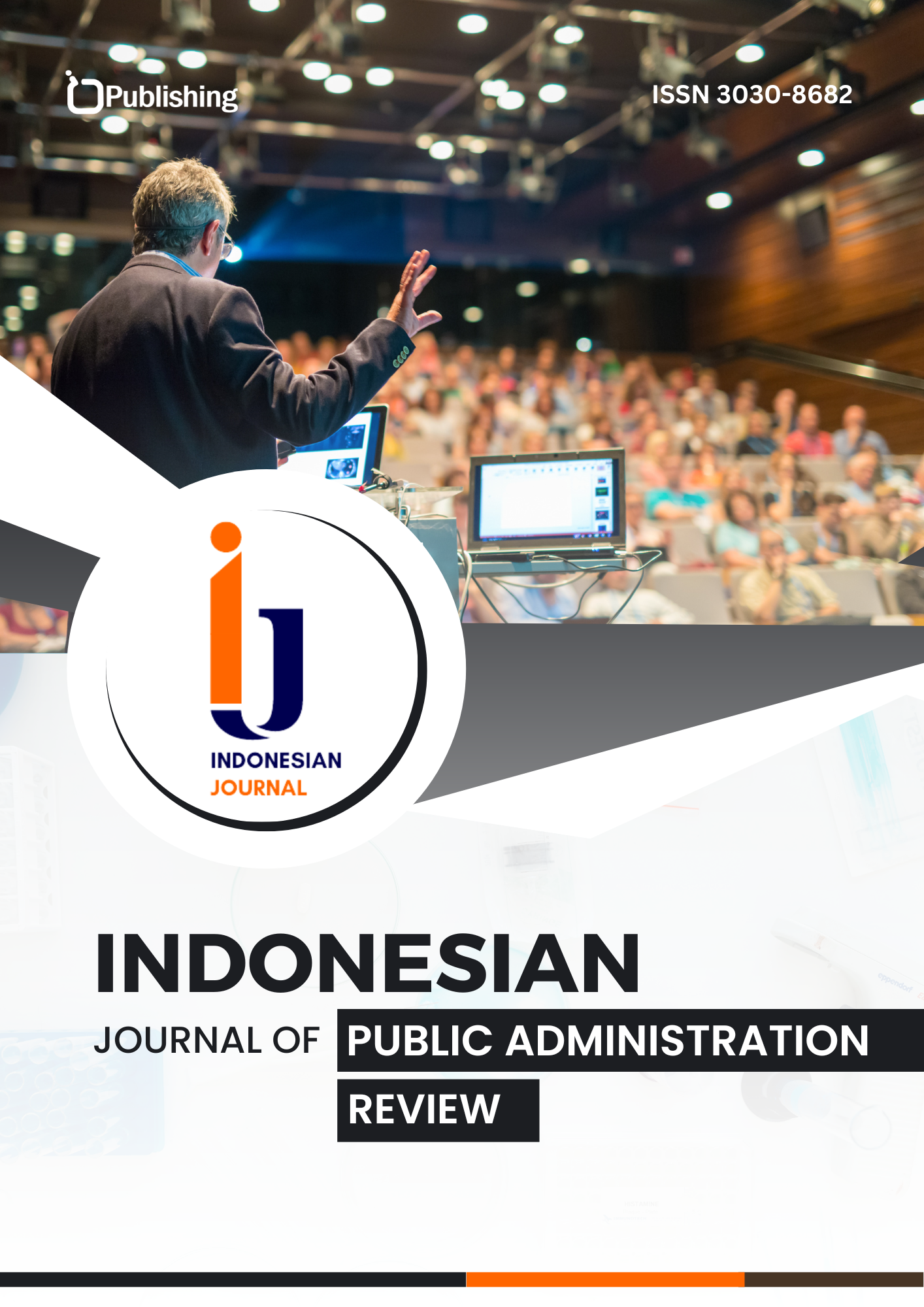Kinerja SDM Aparatur Melalui Pelayanan Administrasi di Desa Kemiri Kecamatan Panti Kabupaten Jember
DOI:
https://doi.org/10.47134/par.v1i1.1938Keywords:
Improvement, Performance, Human Resources, Administrative ServicesAbstract
Improving the performance of village officials is very important, because recently the performance of many village officials in providing services in the village requires quite a long time. This has an impact on existing services in the village. This research looks at the phenomenon of the stages of human resource development in improving the performance of village officials in terms of administrative services. This research aims to analyze improving the quality of human resource performance of apparatus through administrative services in Kemiri Village, Panti District, Jember Regency. The research method used was descriptive qualitative with data collected through interviews, observation, and documentation from various sources, including the Village Head, Village Secretary, Head of Services, Hamlet Head, and the local community. The research results show that there are three important indicators in developing human resources for officials which are related to improving the quality of performance of village officials, namely determining needs, determining program content, and program implementation. To increase the capacity of village officials, there is training held by the sub-district government every month. However, this training is still less effective because the needs and desires of village officials themselves have not been fully met. In order to improve the quality of human resource performance in Kemiri Village, further action needs to be taken, such as providing rewards for village officials who excel, fixing technical problems in launching online administration services, and optimizing training programs by taking into account the needs and desires of village officials. With these steps, it is hoped that improving the quality of HR performance of Kemiri village officials will be better and more effective.
References
Agyabeng-Mensah, Y. (2020). Examining the influence of internal green supply chain practices, green human resource management and supply chain environmental cooperation on firm performance. Supply Chain Management, 25(5), 585–599. https://doi.org/10.1108/SCM-11-2019-0405 DOI: https://doi.org/10.1108/SCM-11-2019-0405
Al-Swidi, A. K. (2021). The joint impact of green human resource management, leadership and organizational culture on employees’ green behaviour and organisational environmental performance. Journal of Cleaner Production, 316. https://doi.org/10.1016/j.jclepro.2021.128112 DOI: https://doi.org/10.1016/j.jclepro.2021.128112
Anwar, N. (2020). Green Human Resource Management for organisational citizenship behaviour towards the environment and environmental performance on a university campus. Journal of Cleaner Production, 256. https://doi.org/10.1016/j.jclepro.2020.120401 DOI: https://doi.org/10.1016/j.jclepro.2020.120401
Cooper, B. (2019). Well-being-oriented human resource management practices and employee performance in the Chinese banking sector: The role of social climate and resilience. Human Resource Management, 58(1), 85–97. https://doi.org/10.1002/hrm.21934 DOI: https://doi.org/10.1002/hrm.21934
Davidescu, A. A. M. (2020). Work flexibility, job satisfaction, and job performance among romanian employees-Implications for sustainable human resource management. Sustainability (Switzerland), 12(15). https://doi.org/10.3390/su12156086 DOI: https://doi.org/10.3390/su12156086
Gilal, F. G. (2019). Promoting environmental performance through green human resource management practices in higher education institutions: A moderated mediation model. Corporate Social Responsibility and Environmental Management, 26(6), 1579–1590. https://doi.org/10.1002/csr.1835 DOI: https://doi.org/10.1002/csr.1835
Haldorai, K. (2022). Top management green commitment and green intellectual capital as enablers of hotel environmental performance: The mediating role of green human resource management. Tourism Management, 88. https://doi.org/10.1016/j.tourman.2021.104431 DOI: https://doi.org/10.1016/j.tourman.2021.104431
Ho, H. (2020). Human resource management systems, employee well-being, and firm performance from the mutual gains and critical perspectives: The well-being paradox. Human Resource Management, 59(3), 235–253. https://doi.org/10.1002/hrm.21990 DOI: https://doi.org/10.1002/hrm.21990
Iriawan, H. (2021). Strategi Pengembangan Sumber Daya Manusia Aparatur Pada Pemerintah Daerah Kabupaten Biak Numfor. DOI: https://doi.org/10.30743/mkd.v5i1.3548
Iskandar, M., & dalam kutipan R., H. (2010). ANALISIS PENELITIAN KUALITATIF MODEL MILES dan HUBERMAN (Sebuah rangkuman dari buku Analisis Data Qualitatif. In Miles, B. Mathew dan Michael Huberman. 1992. Analisis Data Kualitatif Buku Sumber Tentang Metode-metode Baru. Jakarta: UIP.
Kadarisman, Muh. (2019). Efektifitas Kinerja Aparatur Sipil Negara Dalam Pelayanan Administrasi Di Kota Depok. DOI: https://doi.org/10.31113/jia.v16i1.202
Kim, Y. J. (2019). The effect of green human resource management on hotel employees’ eco-friendly behavior and environmental performance. International Journal of Hospitality Management, 76, 83–93. https://doi.org/10.1016/j.ijhm.2018.04.007 DOI: https://doi.org/10.1016/j.ijhm.2018.04.007
Madduppa, N., Juharni, J., & Maldun, S. (2021). Pengembangan Kompetensi Sumber Daya Manusia Dalam Meningkatkan Pelayanan Pada Pelaku Usaha Di Kabupaten Bulukumba. Jurnal Paradigma Administrasi Negara, 3(1), 74–80. https://doi.org/10.35965/jpan.v3i1.600 DOI: https://doi.org/10.35965/jpan.v3i1.600
Maulana, A. (2020a). Pelatihan Pembuatan Rencana Pembangunan Jangka Menengah Desa (RPJM Desa) Di Randuagung Sumberjambe Jember.
Maulana, A. (2020b). Smart City Development Innovation Strategy And Challenges For The Government Of Jember Regency. DOI: https://doi.org/10.1088/1755-1315/717/1/012008
Mousa, S. K. (2020). The impact of green human resource management practices on sustainable performance in healthcare organisations: A conceptual framework. Journal of Cleaner Production, 243. https://doi.org/10.1016/j.jclepro.2019.118595 DOI: https://doi.org/10.1016/j.jclepro.2019.118595
Nisar, Q. A. (2021). Green human resource management practices and environmental performance in Malaysian green hotels: The role of green intellectual capital and pro-environmental behavior. Journal of Cleaner Production, 311. https://doi.org/10.1016/j.jclepro.2021.127504 DOI: https://doi.org/10.1016/j.jclepro.2021.127504
Ogbonnaya, C. (2019). Employee performance, well-being, and differential effects of human resource management subdimensions: Mutual gains or conflicting outcomes? Human Resource Management Journal, 29(3), 509–526. https://doi.org/10.1111/1748-8583.12203 DOI: https://doi.org/10.1111/1748-8583.12203
Papa, A. (2020). Improving innovation performance through knowledge acquisition: the moderating role of employee retention and human resource management practices. Journal of Knowledge Management, 24(3), 589–605. https://doi.org/10.1108/JKM-09-2017-0391 DOI: https://doi.org/10.1108/JKM-09-2017-0391
Peccei, R. (2019). Human resource management–well-being–performance research revisited: Past, present, and future. Human Resource Management Journal, 29(4), 539–563. https://doi.org/10.1111/1748-8583.12254 DOI: https://doi.org/10.1111/1748-8583.12254
Pham, N. T. (2020). The role of green human resource management in driving hotel’s environmental performance: Interaction and mediation analysis. International Journal of Hospitality Management, 88. https://doi.org/10.1016/j.ijhm.2019.102392 DOI: https://doi.org/10.1016/j.ijhm.2019.102392
Roscoe, S. (2019). Green human resource management and the enablers of green organisational culture: Enhancing a firm’s environmental performance for sustainable development. Business Strategy and the Environment, 28(5), 737–749. https://doi.org/10.1002/bse.2277 DOI: https://doi.org/10.1002/bse.2277
Singh, S. K. (2020). Green innovation and environmental performance: The role of green transformational leadership and green human resource management. Technological Forecasting and Social Change, 150. https://doi.org/10.1016/j.techfore.2019.119762 DOI: https://doi.org/10.1016/j.techfore.2019.119762
Sugiyono. (2014). Memahami Penelitian Kualitatif. Alfabeta.
Úbeda-García, M. (2021). Corporate social responsibility and firm performance in the hotel industry. The mediating role of green human resource management and environmental outcomes. Journal of Business Research, 123, 57–69. https://doi.org/10.1016/j.jbusres.2020.09.055 DOI: https://doi.org/10.1016/j.jbusres.2020.09.055
Undang-Undang No 32 Tahun 2004 T.P.D. (2004). Undang-Undang No 32 Tahun 2004 Tentang Pemerintah Daerah. http://www.dpr.go.id/dokjdih/document/uu/33.pdf
Yusoff, Y. M. (2020). Linking Green Human Resource Management Practices to Environmental Performance in Hotel Industry. Global Business Review, 21(3), 663–680. https://doi.org/10.1177/0972150918779294 DOI: https://doi.org/10.1177/0972150918779294
Yusuf, B. (2017). Manajemen sumber daya manusia di lembaga keuangan syariah.
Zaid, A. A. (2018). The impact of green human resource management and green supply chain management practices on sustainable performance: An empirical study. Journal of Cleaner Production, 204, 965–979. https://doi.org/10.1016/j.jclepro.2018.09.062 DOI: https://doi.org/10.1016/j.jclepro.2018.09.062










